About My Mobiles
I create hanging mobiles – a form of kinetic sculpture – from stone, metal and acrylic materials. Mobiles blend movement, balance, and change. The simple abstract components of a mobile interact with each other, yielding a complex form that has the potential for continuous change—the motion of the sculpture transforming it into practically endless configurations. The human eye is designed to detect movement, and motion is a basic way to engage viewers, but the form and design of the sculpture must reward their instinctual gaze. Mobiles also interact with their environment, moving with the breeze or a gust of air. In this way mobiles are uniquely connected to the space they occupy. I tend to think they are necessarily collaborative—that they are most successful when they are specifically designed to work with the building and space that they occupy. Most of my installations benefit from understanding the specifics of the intended setting.
I am artistically interested in how mobiles relate to the spaces they fill. Practically every time I am out around town I notice spaces that would be ideal for hanging art. Consider this, framed art is typically mounted on a wall and traditional sculpture is grounded on the floor, shelf, or pedestal; in contrast, my work is perfect for filling the voids above. My hanging mobiles make use of other areas, space that is frequently neglected.
I have always enjoyed mobiles and I find them captivating; that is the basis of my creative interest. In fact, I love mobiles so much I proposed marriage to my fiancé using one!

She said “Yes!” My proposal mobile which reads “Will you marry me?”
Methods & Materials
My first mobile was constructed in high school, the product of a Modern Art unit in a drawing class. While studying Op Art, which often utilizes implied movement, I branched off into actual movement in three-dimensional space. Since then, mobiles became an interest, then a hobby, then an artistic vocation. In a college sculpture class I constructed my first mobile to use rocks, though in a more “primitive” way using sticks and twine. My first acrylic mobile was completed shortly after college. My familiarity with acrylic materials came from a short stint working at a sign company. The next step in the evolution of my designs came after several small, diverse projects resulted in me becoming familiar with the methods and techniques needed to drill stone. I developed my first stone and steel mobile shortly thereafter. The latest advancement in my techniques is the addition of welding, which has increased the potential scale of my work substantially. I must thank my cousin Tony Ruberto, his company Mechatronic Solutions, and his certified welder Andy Peterson for the welding assistance and tutorials. Looking forward, I see more artistic explorations of scale and color, further applications of metal working, and integrating new materials like fossils into my mobiles.
My mobiles bring certain technical innovations to the art form. As far as I know, I am the first and only artist to use drilled stones coupled to steel rods in a mobile. I also use high grade swivels in my designs, which facilitate more kinetic movement and greater range of motion for each individual element.
My work is completely scalable, from desktop “pebble” mobiles to truly monumental kinetic sculpture. All of my mobiles utilize high quality, high strength swivels and components, and they are meticulously designed and balanced so that each element of the mobile has free rotation and will not collide with the other parts. Most photos of my mobiles picture them arranged with the elements in a single plane; this is for the purposes of clear photography, remember the form is ever-changing when hanging. The mobiles are also stunning when viewed from below, and some of my designs are specifically planned to favor this viewpoint.
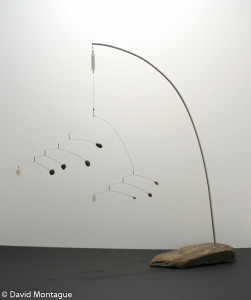
My first pebble mobile, a light and airy desktop mobile. Also, it features a custom desktop stand which I offer for my smaller mobiles.
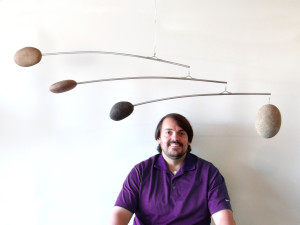
The original prototype for my large stone mobiles, the first to use welding to accommodate the increase in scale. Just imagine one of these with dozens of components.
Another note on my designs, the “footprint” of my mobiles can vary significantly. One design may be very wide with a shallow drop, and another design may be narrow with a large drop.
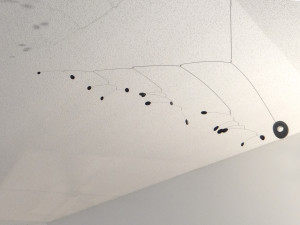
“Reaching Mobile” is an example of a horizontally arranged mobile; the span is much greater than the drop.
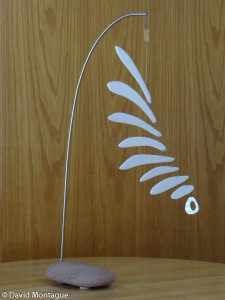
“Acrylic mobile #4,” on the other hand, has a narrow profile with a comparatively larger drop.
If you notice accent holes drilled in the stones or in the sheet material, these are purely aesthetic, although they hint at the challenges of achieving balance. I also offer custom stands, which can turn a mobile into a desktop sculpture or support a mobile when the ceiling is not an option.
I group my mobiles into two broad categories based on material: stone mobiles and sheet material mobiles. Here are some specifics on each:
Stone & Steel Mobiles
My pebble and stone mobiles are made from meticulously selected stones, which are individually drilled and bonded to stainless steel wire or rod. My stones come from a variety of sources, including the shores of Lake Superior and the Mississippi River, as well as from rock retailers. Some stones I have tumbled myself for a smooth shine or luster. Since no two stones are exactly the same, each stone and steel mobile is unique. I maintain a collection of stones to fill the needs of most mobiles, and have become a bit of a rock hound and amateur geologist in the process. I am also experimenting with fossils in place of the stones in some of my mobiles, as well as increasing the scale of these mobiles.
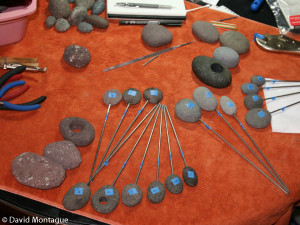
Stone and steel mobile components before assembly.
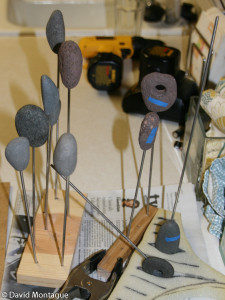
Stone and steel mobile pieces being held while the epoxy dries.
Sheet Material Mobiles
My acrylic sheet/metal sheet mobiles are reminiscent of the work of Alexander Calder, they feature abstract, geometric shapes which are cut from the sheet material and are polished to a shine before the process of balancing and assembly begins. In this medium, the resulting piece can be either the element at the end of a rod, or the entire arm or branch could be composed of the sheet material with no rod. Acrylic material is excellent for small to medium scale mobiles, while metal sheet is more suitable for larger installations. The acrylic components are cut (typically on a scroll saw), sanded and polished in my shop, entirely by me. For large scale sheet metal mobiles, the stainless steel sheet would be cut by hand or by CNC laser/plasma depending on scale and thickness.
Sheet material mobiles are generally more “active” since they have more surface area compared to the stone mobiles. They are also more easily reproduced and are available in any color.
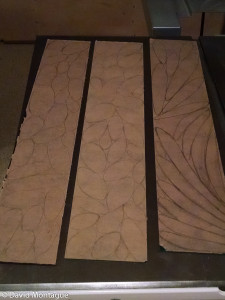
Sheet acrylic, with the masking still on, showing my drawings of pieces to be cut.
I take safety seriously: I mandate an appropriate safety factor in all my components where there is a hanging, dynamic load; if a larger piece requires welded elements, I construct it with the assistance of a certified welder; and I am careful to use the proper materials and techniques in constructing my mobiles.
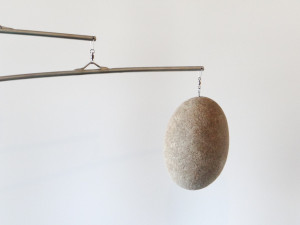
For example, here is a close-up of a large stone mobile. The components may look small, but they include top of the line ball-bearing swivels, with a 350lbs test rating, and stainless steel wire with a 340lbs rating. In this instance, working with a safety factor of ten, that puts the safe load limit of this element at 34lbs.
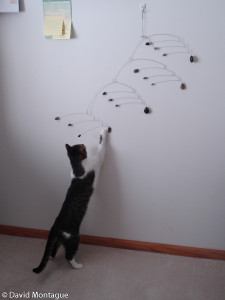
My mobiles are tested for durability and strength. Seriously, our two cats love the mobiles and help make me confident that they can stand up to a certain amount of abuse (although my mobiles are not designed to be toys—for pets or humans).
Commissions & Special Orders
Commissions and special orders are encouraged; since, as previously mentioned, mobiles are most successful when they are in collaboration with the space they occupy.
A popular concept is to take the stones that are significant to you, perhaps stones you’ve collected over the years or stones from a particular location, and commission a mobile incorporating them. For this type of project I generally request more stones than will be needed so that I have some artistic wiggle room. Obviously stones will be drilled and forever changed in this process.
The possibilities of incorporating your items into a mobile are endless. I can envision just about anything balanced in the form of a mobile. So let’s make something that is truly unique and special!
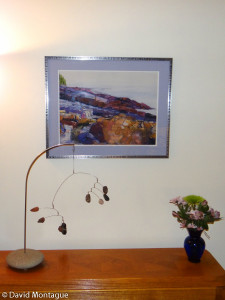
“Chief Lake Mobile” was a commissioned mobile featuring rocks, collected at Chief Lake.
Installation & Maintenance
My mobiles come with helpful installations instructions and require minimal maintenance and cleaning. In fact, the mobiles resist cobwebs because of their movement. It also helps that all my materials are maintenance free: from rust-free stainless steel components, to UV stabilized acrylic sheet, to stones that will be around long after you and I.
Here is a link to the PDF mobile hanging instructions and safety warnings.
